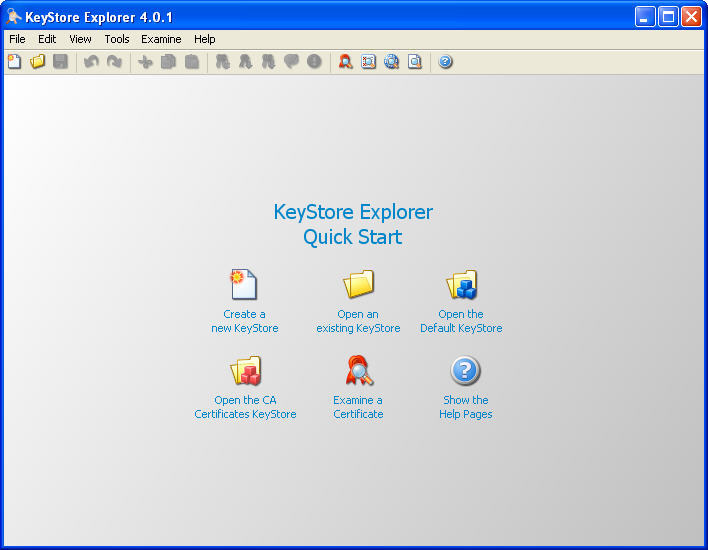


Throws: KeyStoreException - if a KeyStoreSpi Returns: a keystore object of the specified type. Java Cryptography Architecture Standard Algorithm Name Documentationįor information about standard keystore types. Note that the list of registered providers may be retrieved via The specified provider must be registered KeyStoreSpi implementation from the specified provider Returns a keystore object of the specified type. Java Cryptography Architecture Standard Algorithm Name Documentation.Ĭonsult the release documentation for your implementation to see if any To protect the secret key entry, and to store the keystoreĭifferent passwords or other protection parametersĮvery implementation of the Java platform is required to support Load the keystore, to protect the private key entry,
#Keystore explorer open jceks password#
Note that although the same password may be used to Ks.setEntry("secretKeyAlias", skEntry, protParam) įos = new java.io.FileOutputStream("newKeyStoreName") New KeyStore.SecretKeyEntry(mySecretKey) PrivateKey myPrivateKey = pkEntry.getPrivateKey() Ks.getEntry("privateKeyAlias", protParam) KeyStore.PrivateKeyEntry pkEntry = (KeyStore.PrivateKeyEntry) New KeyStore.PasswordProtection(password) To read existing entries from the keystore, or to write new entries Once the keystore has been loaded, it is possible To create an empty keystore using the above load method, get user password and file input streamįis = new java.io.FileInputStream("keyStoreName") Specified keystore type available in the environment.īefore a keystore can be accessed, it must be The system will return the most preferred implementation of the KeyStore ks = KeyStore.getInstance("JKS") The system will return a keystore implementation for the default type. KeyStore ks = KeyStore.getInstance(KeyStore.getDefaultType()) Relying on the default type and providing a specific keystore type. Typical ways to request a KeyStore object include (SafeKeyper) are one option, and simpler mechanisms such as files may also Smart cards or other integrated cryptographic engines Use of a variety of techniques for protecting sensitive (e.g., private or Keystore if it is persistent, are not specified here. Whether keystores are persistent, and the mechanisms used by the To avoid problems, it is recommended not to use aliases in a KeyStore that Whether aliases are case sensitive is implementation dependent. For example, the entity may authenticate itself using differentĬertificate authorities, or using different public key algorithms. In theĬase of private keys and their associated certificate chains, these stringsĭistinguish among the different ways in which the entity may authenticate This type of entry can be used to authenticate other parties.Įach entry in a keystore is identified by an "alias" string. Indeed belongs to the identity identified by the subject (owner) It is called a trusted certificateīecause the keystore owner trusts that the public key in the certificate This type of entry contains a single public key Certificateīelonging to another party. This type of entry holds a cryptographic SecretKey, Applications for this authentication include softwareĭistribution organizations which sign JAR files as part of releasing

Private keys and certificate chains are used by a given entity for It is also accompanied by a certificate chain Which is optionally stored in a protected format to prevent This type of entry holds a cryptographic PrivateKey, Three basic KeyStore.Entry implementations are provided: A keystore is a place that we can hold onto these keys.This class represents a storage facility for cryptographicĪ KeyStore manages different types of entries.Įach type of entry implements the KeyStore.Entry interface. Secret keys can perform these functions as well. Private keys can sign or decrypt data, and public keys can verify or encrypt data. Of course, we can use these keys to service other needs as well. If our keystore format is different than the default, we could use to customize it.

There's no default keystore, so if we want to use an encrypted channel, we'll have to set and. Similarly, if the client also needs to authenticate itself, a situation called mutual authentication, then the client also has a keystore and also presents its public key and certificate. During an SSL handshake, the server looks up the private key from the keystore, and presents its corresponding public key and certificate to the client. Usually, we'll use a keystore when we're a server and want to use HTTPS. Generally speaking, keystores hold keys that our application owns, which we can use to prove the integrity of a message and the authenticity of the sender, say by signing payloads.


 0 kommentar(er)
0 kommentar(er)
